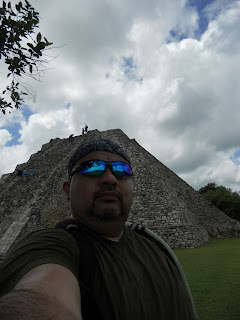Well I finally made it to the great city, as you will see, it is a wonderful and magical place, for those of you who don't know about Mayapan, let me tell you a bit about it.
Mayapan is a Pre-Columbian Maya site a couple of kilometers south of the town of Telchaquillo in the Municipality of Tecoh, approximately 40 km south-east of Mérida and 100 km west of Chichen Itza; in the state of Yucatán, Mexico. Mayapan was the political and cultural capital of the Maya in the Yucatán Peninsula during the Late Post-Classic period from the 1220s until the 1440s.
Mayapan is 4.2 square kilometers and has over 4000 structures most of them residences, are packed into this compound within the city walls, while built-up areas extend a half kilometer beyond the city walls in all directions. The stone perimeter wall has twelve gates, including seven major gates with vaulted entrances. The wall is 9.1 km long and is roughly ovate with a pointed northeast corner. The ceremonial center of the site is located in Square Q of the city's grid in the center of the wider western half of the walled enclosure.
The ceremonial center has a tightly packed cluster of temples, colonnaded halls, oratories, shrines, sanctuaries, altars, and platforms (for oration, dancing, or stela display).
 The Temple of Kukulcan is the main temple in Mayapan. It is located immediately to the east of the Cenote Ch'en Mul, which has caves radiating from it. In form, the Temple of Kukulcan is a radial four-staircase temple with nine terraces that is generally similar to the Temple of Kukulcan at the earlier site of Chichen Itza. There are a number of other major temples in the ceremonial center including three round ones, which are unusual for the Maya area and are also linked to the deity Kukulkan/Quetzalcoatl in his wind god (Ehecatl) aspect. Unlike Chichen Itza, Mayapan has no ballcourts.
The Temple of Kukulcan is the main temple in Mayapan. It is located immediately to the east of the Cenote Ch'en Mul, which has caves radiating from it. In form, the Temple of Kukulcan is a radial four-staircase temple with nine terraces that is generally similar to the Temple of Kukulcan at the earlier site of Chichen Itza. There are a number of other major temples in the ceremonial center including three round ones, which are unusual for the Maya area and are also linked to the deity Kukulkan/Quetzalcoatl in his wind god (Ehecatl) aspect. Unlike Chichen Itza, Mayapan has no ballcourts.

The extensive residential zones of the site are composed of dwellings and ancillary domestic structures. The houses are often arranged in small patio groups surrounding small courtyards. There are many cenotes, perhaps as many as 40, in the residential areas of the site, and settlement is the most dense in the southwestern part of the city where cenotes are more numerous.
Well, this is just a tid bit of information, hope you all enjoy, more to come, lets see what adventures we get in to tomorrow. Enjoy the pictures.























































































Esta es una de las ciudades Mayas k mas me gustan.. y ahi estare otra vez!! wi!!
ReplyDelete